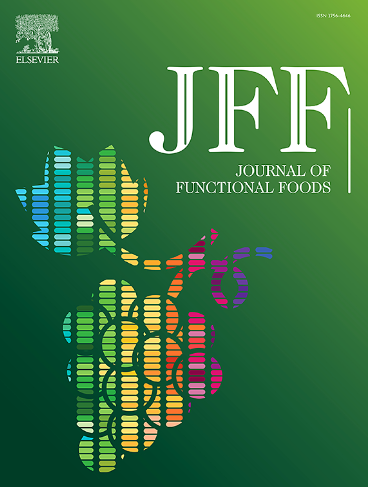Combretum micranthum G. Don (Combretaceae): 它对水电解质代谢、肾小管功能和血压的生理影响
IF 3.8
2区 农林科学
Q2 FOOD SCIENCE & TECHNOLOGY
引用次数: 0
摘要
背景水电解质平衡是维持体内平衡和血压值在狭窄范围内的必要条件。这部分是通过肾脏反应实现的。我们进行了这项研究,以确定小苍兰对水电解质代谢、肾功能和动脉血压的影响:我们对 40 名受试者进行了试验性研究,其中包括 10 名对照组受试者、10 名服用康柏草(400 毫克/天)的受试者、10 名服用呋塞米(120 毫克/天)的受试者和 10 名服用螺内酯(50 毫克/天)的受试者。收集血液和 24 小时尿液样本进行生物测试。食用小苍兰的人的全身脂肪百分比显著下降(-1.63%;p = 0.045)。在食用牛肝菌的人群中,体内水分含量(BWM)明显增加(4.37;p = 0.023),与使用螺内酯治疗的人群相似(0.67;p = 0.042)。与服用呋塞米或螺内酯所引起的高血压指数(收缩压、舒张压和心率)相比,服用牛肝菌能明显降低高血压指数。服用康普坦可显著降低钾血症(-1.07;p < 0.0001),而对钠血症(p = 0.119)和胆汁淤积症(p = 0.708)没有明显影响。与此相反,呋塞米和螺内酯可显著降低血钠潴留(分别为-0.80;p = 0.022 和-0.50;p = 0.009)。在康莫司群组中,利尿和利胆作用明显增加(分别为 373.9;p = 0.005 和 441.3;p = 0.028),有趣的是,我们发现利钠作用显著下降(-193.3;p = 0.074)。在服用呋塞米的受试者组中,利尿和利胆作用显著增加(分别为 380.24;p = 0.013 和 425.5;p = 0.013),但有增加纳尿作用的趋势。在服用螺内酯的受试者组中,所研究的三种电解质的尿液浓度(钠尿症、钠尿症和氯尿症)显著增加(分别为 357.5;p = 0.037 和 222.5;p = 0.005 和 563.4;p = 0.007)。这些作用可归因于其多酚成分。要更好地了解这些作用的生理机制,还需要进行更广泛的研究。本文章由计算机程序翻译,如有差异,请以英文原文为准。
Combretum micranthum G. Don (Combretaceae): Its physiological effects on hydro-electrolyte metabolism, renal tubular function and blood pressure
Background
Hydro-electrolyte balance is necessary to maintain body homeostasis and blood pressure values within narrow limits. This is accomplished, in part, by renal responses. We conducted this study to determine the effects of Combretum micranthum on hydro-electrolyte metabolism, renal function and arterial blood pressure.
Subjects and methods
We conducted a pilot study including 40 subjects: 10 control subjects, 10 subjects under Combretum micranthum G. Don (400 mg/day), 10 subjects under furosemide (120 mg/day), and 10 subjects under spironolactone (50 mg/day).
Anthropobiometric, cardiovascular parameters and the body composition were collected from each subject. Blood and 24-hour urine samples were collected for biological tests.
Results
At baseline, clinical and biological parameters were comparable for all groups. Consumers of combretum micranthum had a significant decrease in global body fat percentage (−1.63 %; p = 0.045). In the group of combretum micranthum consumers, the body water mass (BWM) is significantly evolved in the direction of an increase (4.37; p = 0.023) and similar to what was observed in the group of subjects treated with spironolactone (0.67; p = 0.042). Consumption of combretum micranthum showed a marked reduction in hypertension indices (systolic blood pressure, diastolic blood pressure and heart rate) identical to that induced by consumption of furosemide or spironolactone. The consumption of combretum micranthum resulted in a significant reduction in kaliemia (−1.07; p < 0.0001) and without any notable effect on natremia (p = 0.119) and chloremia (p = 0.708). In contrast, furosemide and spironolactone caused a significant decrease in natremia (respectivly, −0.80; p = 0.022 and −0.50; p = 0.009). In the combretum micrathum group, the kaliuresis and the chloruresis were significantly increased (respectively, 373.9; p = 0.005 and 441.3; p = 0.028), interestingly, we found a remarkable decrease in natriuresis (−193.3; p = 0.074). In the group of furosemide consumers, the kaliuresis and the chloruresis were significantly increased (respectively, 380.24; p = 0.013 and 425.5; p = 0.013), but with a tendency to increase natriuresis. In the group of subjects taking spironolactone, the urinary concentrations of the three electrolytes studied (natriuresis, kaliuresis and chloruresis) was increased significantly (respectively, 357.5; p = 0.037 and 222.5; p = 0.005 and 563.4; p = 0.007).
Conclusion
Combretum micranthum would have constituents involved in the maintenance of hydro-electrolyte homeostasis and in the regulation of blood pressure through the involvement of several mechanisms, especially at the renal level. These actions would be attributable to its polyphenolic components. A broader study is needed to better understand the physiological mechanisms underlying these effects.
求助全文
通过发布文献求助,成功后即可免费获取论文全文。
去求助
来源期刊

Journal of Functional Foods
FOOD SCIENCE & TECHNOLOGY-
CiteScore
9.60
自引率
1.80%
发文量
428
审稿时长
76 days
期刊介绍:
Journal of Functional Foods continues with the same aims and scope, editorial team, submission system and rigorous peer review. We give authors the possibility to publish their top-quality papers in a well-established leading journal in the food and nutrition fields. The Journal will keep its rigorous criteria to screen high impact research addressing relevant scientific topics and performed by sound methodologies.
The Journal of Functional Foods aims to bring together the results of fundamental and applied research into healthy foods and biologically active food ingredients.
The Journal is centered in the specific area at the boundaries among food technology, nutrition and health welcoming papers having a good interdisciplinary approach. The Journal will cover the fields of plant bioactives; dietary fibre, probiotics; functional lipids; bioactive peptides; vitamins, minerals and botanicals and other dietary supplements. Nutritional and technological aspects related to the development of functional foods and beverages are of core interest to the journal. Experimental works dealing with food digestion, bioavailability of food bioactives and on the mechanisms by which foods and their components are able to modulate physiological parameters connected with disease prevention are of particular interest as well as those dealing with personalized nutrition and nutritional needs in pathological subjects.
 求助内容:
求助内容: 应助结果提醒方式:
应助结果提醒方式:


